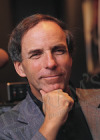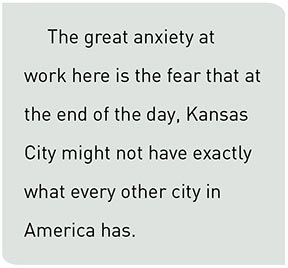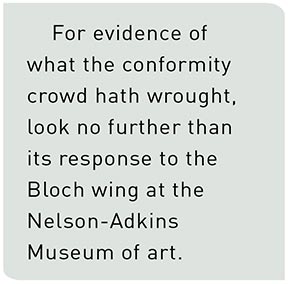HOME | ABOUT US | MEDIA KIT | CONTACT US | INQUIRE
HOME | ABOUT US | MEDIA KIT | CONTACT US | INQUIRE

I am not sure when it happened. The seeds may have been planted as early as 1939, when Tom Pendergast shuffled off to Leavenworth and took much of Kansas City’s color with him. For sure, though, sometime between then and now,
civic leaders decided we had gone about as far as we could go. It was high time to make Kansas City America’s least distinctive city.
The city’s Whiggish elites discouraged invention, derided originality, and cringed at uniqueness. If they had their way, no one would be singing about Kansas City any time in the future.
The rejection of the Funkhouser mayoralty sealed the deal. Kansas City rededicated itself to mimicking other cities, and new mayor, Sly James, was just the man for that job. In the James era, as in the Barnes era, before him, no unoriginal idea was off limits.
When questioned about whether Kansas City, Missouri should invest its scarce resources in a $300 million Downtown hotel that may or may not work as planned, James said it best, “So we shouldn’t try? We should accept being behind?”
So saying, James tapped the great Whig anxiety, the fear that at the end of the day the city would not have exactly what every other city in America had. For James and other civics leaders “behind” really meant “unlike.” If every other city in America had a sterile, half-empty downtown convention hotel, why not us?

The High Costs of Fear
This fear spurred the drive to build an extravagantly expensive new airport, one that no taxpayer without his finger in the pie wanted to see built. The fact that it would inconvenience every single resident of the Kansas City region for decades to come had something to do with public resistance. Still, if every other city in America has a bland, traffic-choked single terminal, why not us?
This fear inspired an utterly gratuitous, two-mile, north-south KC Downtown Streetcar “starter” line that no one but the planners want to see started, let alone “finished.”
“It is expected that in early 2016 the first streetcar rides will occur through Downtown Kansas City in over a half a century,” the planners boasted, reflecting not for a moment on why it was a better idea in the present than in the past. But hey, if every other city in America had an under-used, over-priced streetcar line, why not us?
Perversely, this same fear has been driving the Kansas City Council to consider raising the city’s minimum wage to $15 an hour. Seattle has done it. San Francisco has done it. Los Angeles has done it. So why not us? The fact that there is a rival state within spitting distance—one with its own convention hotels—will not discourage our civic mimics. Ideas don’t have to be good. They just have to be duplicable.
It wasn’t always thus. J.C. Nichols turned a hog farm into the Country Club Plaza. Now, people routinely refer to this nearly century-old enterprise as “America’s first shopping center.” Then, they called it “Nichols’ folly.” No one had ever done such a thing before. Unlike the Downtown hotel people, Nichols didn’t need a $13 million land grant from the city and $2 million in annual tax vig to inspire him.
Kansas City jazz has not always been mummified and relegated to weary museums. Years back, our musicians created it right here and exported it worldwide. No one gave them $48,000 pianos to practice on. No one gave them grants or tax breaks. There was a real demand for their product, and that product found its market.
In the 1970s, the River Quay rocked. Unlike the Power & Light District, this high-energy entertainment area exploded on to the scene more or less spontaneously. Of course, it exploded off the scene, as well. Spontaneity can have its downside, but if nothing else, the demolition came free.

Kansas City continues to create, but it does so often without the knowledge and approval of our planners and almost always without their help. The things we find ourselves bragging about tend to be the ideas, like Nichols’ folly, that the planning class pooh-poohed.
The authorities tried to prevent the blue-collar Hawley family and their associates from exhuming the Steamboat Arabia and creating America’s most successful entrepreneurial museum around it. Working on their own dime, these guys spent less money digging up the boat and building the museum than the city spent on cost overruns for the lifeless museums on 18th Street.
When Henry Bloch commissioned architect Stephen Holl to oversee the expansion of the Nelson-Atkins museum, local champions of orthodoxy squawked. “It suddenly dawned upon this critic,” wrote one typical reviewer, “that what it had taken for an ugly old shipping container was actually the building closest to completion!”
The “shipping container” dig was just a fresh variation on an already tired line of insults along an oddly agro-industrial theme. The folks at the Nelson had heard them all: “Butler building,” “corn crib,” “agricultural storage building.” It was not until Time magazine ranked the new Bloch Building No. 1 on its 2007 list of “The 10 Best (New and Upcoming) Architectural Mar-vels” that the critics stopped clucking. Outsiders now approved. All was OK.
Without anyone paying it much mind, the historic West Bottoms District has emerged as the hottest spot in the Midwest for antique lovers and vintage collectors. On the other side of Downtown, the wildly original Knuckleheads Saloon has alerted much of Kansas City to the fact that there actually is an East Bottoms, as well.
No city planner could have ever conceived a Knuckleheads. No City Council would have approved it. No city without a Knuckleheads can ever be much of a city. Let us be.